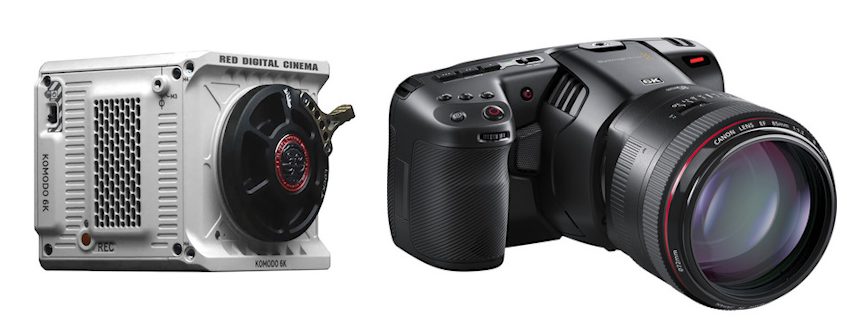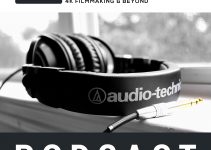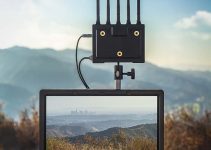Professional cinema cameras just seem to keep getting smaller and smaller, and though neither one of these impressive, high-resolution systems could actually fit in your pocket (unless you, yourself, are a giant), you won’t have to completely empty your pockets to afford them.
This is nothing new for Blackmagic, their disruptive business model depends on offering feature-packed cameras for unbelievably low prices like $1,998 for the Pocket 6K. RED, on the other hand, is entering into new territory with the Komodo at $6,000.
The $4K difference in price might seem a bit unwarranted to some would-be buyers. After all, these two 6K cameras seem to share a lot of similar specs on paper. Maybe the premium price is justifiable, and maybe it isn’t. Can spot the difference between the two at a glance? Geoff Fagien of Reach Films hooked us up with this side-by-side image quality test to see if your trained eyes are sharp enough to tell which is which.
In our unending pursuit for the advancement of human leisure, we’ve created some marvelous devices with which to capture things-to-look-at. The motion picture industry is a massive business and massive businesses require the crème de la crème, the cutting edge.
Millions and Millions of eyeballs are staring at these pictures, consciously or unconsciously scrutinizing every nuance and any deviation from perfect is an excuse for them to look away. At least, that’s what we tell ourselves.
You can’t shake a stick at either of these cameras; They both produce absolutely stunning images in the hands of a trained, experienced professional.
RED Komodo Key Features
- Active Canon RF Mount
- Super 35-Sized Sensor
- Cfast 2.0 Media
- Record 6K 6144 x 3240 up to 40fps
- Max ISO 12800
- R3D (REDCODE RAW) Internal Recording
- ProRes Internal Recording
- Price ~$6,000
BMPCC 6K Key Features
- Active Canon EF/EF-S Mount
- Super 35-Sized HDR Sensor
- Cfast 2.0 Media
- Record 6K 6144 x 3456 up to 50 fps
- Dual Native 400 & 3200 ISO to 25,600
- BRAW Internal Recording
- ProRes Internal Recording
- Price: $1,995
Let’s have a look at some frame grabs the comparison video. They are compressed, though, and I definitely recommend watching them in high resolution on YouTube and subscribe to Reach Films’ channel while you’re at it.
As you can see in the examples from Greg’s video the resolution of these two cameras are nearly identical. Despite the $4,000 price difference, the Komodo fails to produce a sharper image than the Pocket 6K. But that isn’t where the Komodo shines over the BMPCC 6K.
The future of filmmaking isn’t in the resolution of the image. We got to a point that was beyond the limitations of our eyes a long time ago. (I wrote an article about that if you’re curious.) The mark of professional cameras in today’s modern world is dynamic range, and that’s where the Komodo really takes the lead.
We can easily see the subtle, but crucial difference between these two cameras in the highlights. So much more information is visible in the footage from the Komodo (A) than what we’re seeing from the BMPCC 6K. Additionally, the 16-Bit color from the Komodo really tramples over the 12-Bit color from the Blackmagic Camera.
The subtle rolloff in gradient in the subject’s face and fantastic color science of the Komodo are also so very apparent and pleasing to the eyes.
I know the Blackmagic Pocket 6K to be a fantastic camera, which is why this is so shocking to me. This footage from the Komodo is simply breathtaking.
But with a little bit of extra work, the BMPCC 6K can look almost indistinguishable from the Komodo. Not every scene that you’ll film will have 16 stops of dynamic range; many shots might have 10 or less depending on what is being filmed and in those moments would anyone be able to tell what you used?
ISO Comparison
Further ISO testing by Geoff shows the Pocket 6K resolving a much cleaner image at 3200 ISO than the Komodo. This is largely due to the Pocket 6K’s dual native ISO of 400 an 3200, in which a second set of amplifiers kick in that are tuned to deliver the lowest signal to noise ratio possible.
Neither of these cameras is a low-light camera like the A7S III, and you can clearly see that setting them to any ISO above their native reduces their dynamic range substantially.
No one camera is going to be perfect for every situation, and if low light shooting is your primary work, you might be better served by a purpose-built camera.
Ergonomics & Usability
Neither one of these cameras is very ergonomic. At least the BMPCC 6K has a built-in handgrip – the Komodo is just a box!

But the size and shape of the Komodo make it much easier to rig, not just on gimbals but just in simple handheld configurations where you can counterbalance the rear battery weight with the weight of the lens.
On top of that, battery life is a massive issue with the BMPCC 6K. A single LP-E6 battery will only last 30-45 minutes in the Pocket 6k. The Komodo has 2x Canon BP battery slots, and a single BP-970 battery can last for around 1.5 hours. That is a 3 hour total runtime with the camera fully loaded. In a shoot day, you could expect to swap batteries 2-4 times (depending on what you’re shooting and how) with the Komodo, but the Pocket 6K might require 8-16 batteries changes for an 8-hour shoot.
There are workarounds with battery grips, external solutions, etc but even with those, there is nothing out there that is absolutely perfect. The Pocket 6K always winds up just awkwardly balanced (top-heavy, bottom-heavy, side heavy) and that can affect how you shoot. The Komodo is easier to rig, power, balance, and monitor (with the Red_Control app).
It will always depend on what you shoot, not how you shoot; but starting off on the right foot with anything is the best way to get going. You can definitely see the added quality the Komodo brings to the table. Does everyone need it? Probably not. Is it worth the extra $4,000? That’s for you to decide.
[source: Reach Films]
Order Links:
Disclaimer: As an Amazon Associate partner and participant in B&H and Adorama Affiliate programmes, we earn a small comission from each purchase made through the affiliate links listed above at no additional cost to you.



